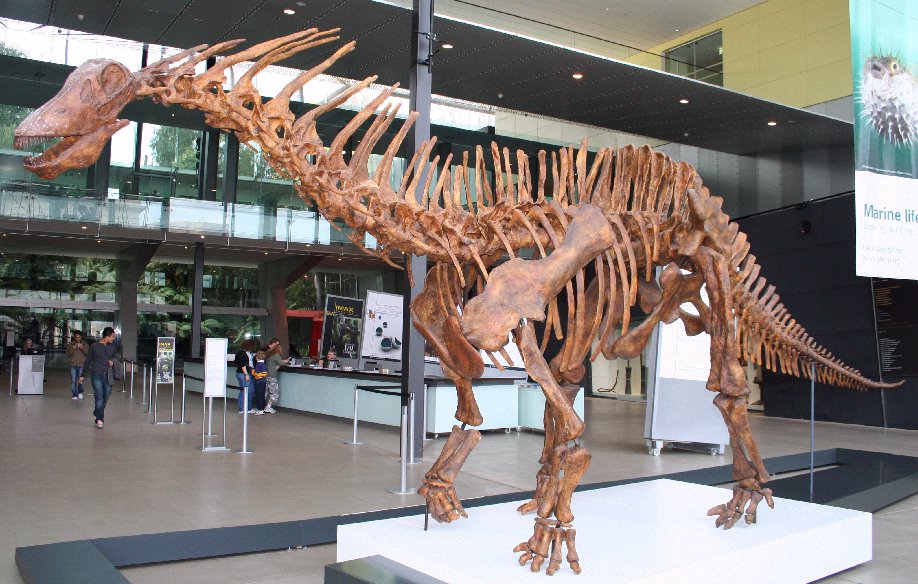Facts for Kids
Amargasaurus is a genus of sauropod dinosaurs known for its distinctive elongated spines and herbivorous diet, native to Early Cretaceous Argentina.
Overview
Cultural Significance
Importance In Ecosystem
Habitat And Distribution
Physical Characteristics
Diet And Feeding Behavior
Discovery And Fossil History
Behavior And Social Structure
Related Species And Evolution

Inside this Article
Brachiosaurus
South America
Imagination
Argentina
Skeleton
Dinosaur
Time
Neck
Day
Did you know?
🦖 Amargasaurus was a sauropod dinosaur that lived during the Early Cretaceous period.
🌍 Fossils of Amargasaurus have been found in what is now Argentina.
👶 Amargasaurus grew to a length of approximately 30 feet (9 meters).
🦙 This dinosaur is known for the distinctive elongated spines on its neck and back.
🍃 Amargasaurus was a herbivore, primarily feeding on plants.
🐾 It is believed that the spines on Amargasaurus may have been covered in skin, forming a sail-like structure.
🏞️ Amargasaurus lived in a semi-arid environment filled with lush vegetation.
🦴 The name 'Amargasaurus' means 'bitter lizard' in reference to the geological region where its fossils were found.
🎨 The unique spines may have served a purpose in display or thermoregulation.
🕰️ Amargasaurus roamed the Earth approximately 130 million years ago.
Introduction
This friendly giant lived in what is now Argentina. Amargasaurus was a sauropod, which means it belonged to a group of dinosaurs known for their long necks and tails. It measured about 30 feet (9 meters) long! What’s cool about Amargasaurus is that it had two rows of tall, spiky vertebrae along its neck and back which might have looked like a sail! 🌈
Dinosaurs like Amargasaurus were herbivores, munching on leaves and plants.
Cultural Significance
It has appeared in books, movies, and toys, making it a popular dinosaur among young dino fans. Learning about Amargasaurus can teach us about dinosaurs’ ancient lives and their incredible adaptations. Museums often display its fossils, helping to inspire future paleontologists! 🦖
People can visit places like the Museo de La Plata in Argentina to see these fascinating dinosaur remains!
Importance In Ecosystem
It helped shape the landscape by munching on plants, which allowed new plants to grow and provided food for other creatures. Furthermore, by moving through the environment, Amargasaurus may have helped spread seeds through its droppings. This means that by eating, it helped the forest flourish! 💚
In a way, this dinosaur was a gardener of the ancient world, contributing to a healthy ecosystem for many living things!
Habitat And Distribution
The environment during the Early Cretaceous period had plenty of lush greenery and tall trees for Amargasaurus to feed on. It likely would have lived near rivers and lakes, where it could drink water. The fossil sites in Argentina show that this region was once rich with diverse plants and animals, providing a perfect home for Amargasaurus and its friends!
Physical Characteristics
It was covered in rough skin, which may have helped protect it from predators. One of its most extraordinary features was the double row of spiky vertebrae along its neck and back. These spikes could have been used for show to attract mates or scare off enemies! 🦕
Although we can’t know for sure, some scientists think that it may have had colorful skin or even feathers, making it look vibrant and impressive.
Diet And Feeding Behavior
It mainly ate leaves, ferns, and shrubs. Its long neck allowed it to reach high treetops to snack on delicious greenery. With its flat teeth, it could easily crush tough plant material. Sometimes, it might have also used its neck to forage on the ground for low-growing plants! Amargasaurus likely spent most of its day eating to stay strong and healthy, just like we eat our veggies! 🥦
Discovery And Fossil History
These fossils included neck bones, vertebrae, and some leg bones. Scientists worked hard to piece together the skeleton. They figured out that the spines on its back were about 3 feet tall! 🦖
Fossils are the remains of ancient creatures that got buried under layers of mud, which helped preserve them. The name Amargasaurus means "bitter lizard," named after the Amarga Valley, where its remains were found.
Behavior And Social Structure
They might have traveled in herds to help protect each other from predators, like the fearsome carnivores of their time! Being in a herd would also help them find more food with their friends. They might have communicated through sounds and body language, just like animals today. Whether they were playing or staying safe, living in a group could have made life more fun for our friend Amargasaurus!
Related Species And Evolution
They all shared similar characteristics such as long necks and tails. Scientists believe that sauropods evolved from smaller, earlier dinosaurs. Over time, they grew larger to reach higher vegetation and outcompete other herbivores for food. By studying fossils of related species, scientists learn about how dinosaurs adapted to their environments millions of years ago. 🦕

